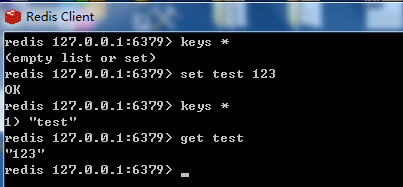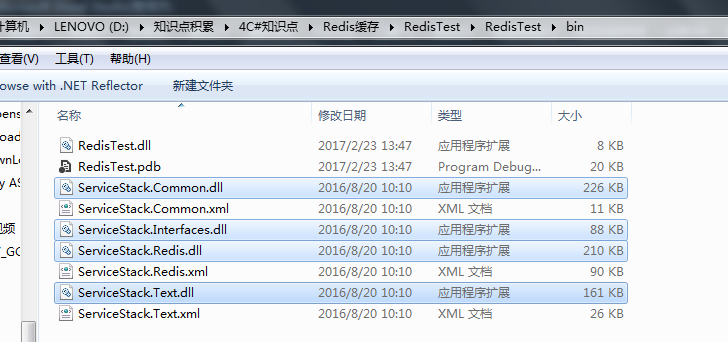1:使用Redis緩存的優(yōu)化思路
redis的使用場景很多,僅說下本人所用的一個場景:
1.1對于大量的數(shù)據(jù)讀取,為了緩解數(shù)據(jù)庫的壓力將一些不經(jīng)常變化的而又讀取頻繁的數(shù)據(jù)存入redis緩存
大致思路如下:執(zhí)行一個查詢
1.2首先判斷緩存中是否存在,如存在直接從Redis緩存中獲取。
1.3如果Redis緩存中不存在,實時讀取數(shù)據(jù)庫數(shù)據(jù),同時寫入緩存(并設(shè)定緩存失效的時間)。
1.4缺點,如果直接修改了數(shù)據(jù)庫的數(shù)據(jù)而又沒有更新緩存,在緩存失效的時間內(nèi)將導(dǎo)致讀取的Redis緩存是錯誤的數(shù)據(jù)。
2:Redis傻瓜式安裝
2.1雙擊執(zhí)行redis-2.4.6-setup-64-bit.exe程序(下載地址:https://github.com/dmajkic/redis/downloads)
2.2可以將此服務(wù)設(shè)置為windows系統(tǒng)服務(wù):

2.3測試是否安裝成功:
再回到redis文件夾下,找到redis-cli.exe文件,它就是Redis客戶端程序。打開,輸入:
Set test 123
即在Redis中插入了一條key為test,value為123的數(shù)據(jù),繼續(xù)輸入:get test
得到value保存的數(shù)據(jù)123。
如果想知道Redis中一共保存了多少條數(shù)據(jù),則可以使用:keys * 來查詢:

3:asp.net使用Redis緩存簡單示例
3.1測試Demo的結(jié)構(gòu)

3.2添加引用

3.3將參數(shù)寫入配置文件
|
1
2
3
4
5
6
7
8
9
|
<appSettings><add key="WriteServerList" value="127.0.0.1:6379" /><add key="ReadServerList" value="127.0.0.1:6379" /><add key="MaxWritePoolSize" value="60" /><add key="MaxReadPoolSize" value="60" /><add key="AutoStart" value="true" /><add key="LocalCacheTime" value="1800" /><add key="RecordeLog" value="false" /></appSettings> |
3.4讀取配置文件參數(shù)類
|
1
2
3
4
5
6
7
8
9
|
public class RedisConfigInfo{ public static string WriteServerList = ConfigurationManager.AppSettings["WriteServerList"]; public static string ReadServerList = ConfigurationManager.AppSettings["ReadServerList"]; public static int MaxWritePoolSize = Convert.ToInt32(ConfigurationManager.AppSettings["MaxWritePoolSize"]); public static int MaxReadPoolSize = Convert.ToInt32(ConfigurationManager.AppSettings["MaxReadPoolSize"]); public static int LocalCacheTime = Convert.ToInt32(ConfigurationManager.AppSettings["LocalCacheTime"]); public static bool AutoStart = ConfigurationManager.AppSettings["AutoStart"].Equals("true") ? true : false;} |
3.5連接Redis,以及其他的一些操作類
|
1
2
3
4
5
6
7
8
9
10
11
12
13
14
15
16
17
18
19
20
21
22
23
24
25
26
27
28
29
30
31
32
33
34
35
36
37
38
39
40
41
42
43
44
45
46
47
48
49
50
51
52
53
54
55
56
57
58
59
60
61
62
63
64
65
66
67
68
69
70
71
72
73
74
75
76
77
78
79
80
81
82
83
84
|
public class RedisManager { private static PooledRedisClientManager prcm; /// <summary> /// 創(chuàng)建鏈接池管理對象 /// </summary> private static void CreateManager() { string[] writeServerList = SplitString(RedisConfigInfo.WriteServerList, ","); string[] readServerList = SplitString(RedisConfigInfo.ReadServerList, ","); prcm = new PooledRedisClientManager(readServerList, writeServerList, new RedisClientManagerConfig { MaxWritePoolSize = RedisConfigInfo.MaxWritePoolSize, MaxReadPoolSize = RedisConfigInfo.MaxReadPoolSize, AutoStart = RedisConfigInfo.AutoStart, }); } private static string[] SplitString(string strSource, string split) { return strSource.Split(split.ToArray()); } /// <summary> /// 客戶端緩存操作對象 /// </summary> public static IRedisClient GetClient() { if (prcm == null) CreateManager(); return prcm.GetClient(); } /// <summary> /// 緩存默認24小時過期 /// </summary> public static TimeSpan expiresIn = TimeSpan.FromHours(24); /// <summary> /// 設(shè)置一個鍵值對,默認24小時過期 /// </summary> /// <typeparam name="T"></typeparam> /// <param name="key"></param> /// <param name="value"></param> /// <param name="redisClient"></param> /// <returns></returns> public static bool Set<T>(string key, T value, IRedisClient redisClient) { return redisClient.Set<T>(key, value, expiresIn); } /// <summary> /// 將某類數(shù)據(jù)插入到list中 /// </summary> /// <typeparam name="T"></typeparam> /// <param name="key">一般是BiaoDiGuid</param> /// <param name="item"></param> /// <param name="redisClient"></param> public static void Add2List<T>(string key, T item, IRedisClient redisClient) { var redis = redisClient.As<T>(); var list = redis.Lists[GetListKey(key)]; list.Add(item); } /// <summary> /// 獲取一個list /// </summary> /// <typeparam name="T"></typeparam> /// <param name="key"></param> /// <param name="redisClient"></param> /// <returns></returns> public static IRedisList<T> GetList<T>(string key, IRedisClient redisClient) { var redis = redisClient.As<T>(); return redis.Lists[GetListKey(key)]; } public static string GetListKey(string key, string prefix = null) { if (string.IsNullOrEmpty(prefix)) { return "urn:" + key; } else { return "urn:" + prefix + ":" + key; } } } |
3.6測試頁面前后臺代碼
|
1
2
3
4
5
6
|
<form id="form1" runat="server"> <div> <asp:Label runat="server" ID="lbtest"></asp:Label> <asp:Button runat="server" ID ="btn1" OnClick="btn1_Click" Text="獲取測試數(shù)據(jù)"/> </div> </form> |
|
1
2
3
4
5
6
7
8
9
10
11
12
13
14
15
16
17
18
|
protected void btn1_Click(object sender, EventArgs e) { string UserName; //讀取數(shù)據(jù),如果緩存存在直接從緩存中讀取,否則從數(shù)據(jù)庫讀取然后寫入redis using (var redisClient = RedisManager.GetClient()) { UserName = redisClient.Get<string>("UserInfo_123"); if (string.IsNullOrEmpty(UserName)) //初始化緩存 { //TODO 從數(shù)據(jù)庫中獲取數(shù)據(jù),并寫入緩存 UserName = "張三"; redisClient.Set<string>("UserInfo_123", UserName, DateTime.Now.AddSeconds(10)); lbtest.Text = "數(shù)據(jù)庫數(shù)據(jù):" + "張三"; return; } lbtest.Text = "Redis緩存數(shù)據(jù):" + UserName; } } |
測試結(jié)果圖
首次訪問緩存中數(shù)據(jù)不存在,獲取數(shù)據(jù)并寫入緩存,并設(shè)定有效期10秒

10秒內(nèi)再次訪問讀取緩存中數(shù)據(jù)

以上就是本文的全部內(nèi)容,希望本文的內(nèi)容對大家的學(xué)習(xí)或者工作能帶來一定的幫助,同時也希望多多支持服務(wù)器之家!
原文鏈接:http://www.cnblogs.com/weity/p/6481469.html












